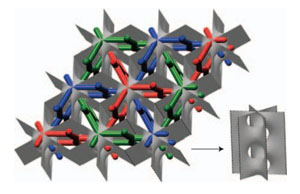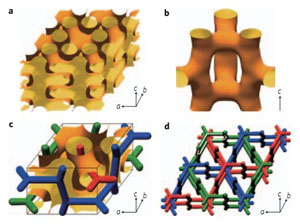A solid, but sponge-like material has been synthesised by chemists in Singapore. The silica-type material has the most complicated pore structure ever reported and is discussed in the latest issue of the new journal Nature Chemistry.
Mesoporous silica is a technologically important material, that extends the basic principle of porous silica to a specific range of pore size: 2 to 50 nanometres. Materials with pores smaller than this are microporous and anything bigger is macroporous. The meso materials in the middle have great potential in catalysis, chemical separation, gas storage, drug delivery and even imaging. All important for particular applications is the precise size and shape of the pores. Different shapes will be responsive to specific small molecules that might enter in different ways and have diverse effects on how the material interacts or changes those small molecules.

The mesoporous IBN-9 structure (Credit: Ying et al/Nature Chem.)
The size of the pores also endows any such porous material with a huge internal surface area in a given small volume that would if laid flat cover dozens of football pitches. It is this enormous surface to volume ratio – often around one thousand square metres per gram – that endows mesoporous materials with the ability to absorb, or more strictly adsorb, large volumes of small molecules.
Until now, such materials have been limited to a single network of pores, or at most two disconnected pore systems. This gives them enormous potential as sieves for separating molecules if a mixture of large and small molecules is strained through the material only those that fit the pores can be adsorbed. Such porous materials are essential to the process of catalytic cracking in the petroleum industry in which every molecule found in vehicle fuels has essentially passed through such a material.

Various views of the IBN-9 pores (Credit: Ying et al/Nature Chem.)
Now, Jackie Ying, Yu Han, Leng Leng Chng, and Lan Zhao of the Institute of Bioengineering and Nanotechnology, in Singapore, and colleagues Daliang Zhang, Junliang Sun, and Xiaodong Zou of the Berzelii Center EXSELENT on Porous Materials, in Stockholm, Sweden, have created a mesoporous silica that has not two but three interwoven but disconnected pore systems. This added layer of complexity gives chemists an extra variable with which to work in creating pore sizes and shapes tailored to particular molecules and so particular types of chemical separation or catalytic process.
To make their new triply porous material, known as IBN-9, Ying and colleagues designed a new templating agent around which the complex structure formed. The template compound, a surfactant made from N,N-dimethyl-L-phenylalanine in two steps, has large head-groups and long hydrocarbon tails ending with an amine group. The template then acts as a support around which silica can grow and crystallise, dissolving the template leaves behind the mesoporous silica.
By fine-tuning the ratio of molecular size to head-group and the degree of water repellence, or hydrophobicity, of the tail, the researchers can design the pores of the new materials. They suggest that the presence of both long and short channels in fibres of the material could lead to separation or controlled-release applications that offer different diffusion rates in different directions.
Further reading
Nature Chem., 2009, 1, in press
http://dx.doi.org/10.1038/nchem.166